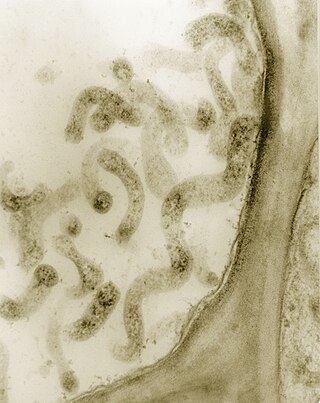
Ureaplasma is a genus of bacteria belonging to the family Mycoplasmataceae. As the name implies, Ureaplasma is urease positive.

Desulfovibrionales are a taxonomic order of bacteria belonging to the phylum Thermodesulfobacteriota, with four families. They are Gram-negative. The majority are sulfate-reducing, with the exception of Lawsonia and Bilophila. All members of this order are obligately anaerobic. Most species are mesophilic, but some are moderate thermophiles.
The Syntrophobacterales are an order of Thermodesulfobacteriota. All genera are strictly anaerobic. Many of the family Syntrophobacteraceae are sulfate-reducing. Some species are motile by using one polar flagellum.

Entomoplasmatales is a small order of mollicute bacteria.
Anaeroplasmatales is an order of mollicute bacteria which are generally found in the rumens of cattle and sheep. The only family in the order is the family Anaeroplasmataceae.
The Thermoactinomycetaceae are a family of Gram-positive endospore-forming bacteria.

The Erysipelotrichaceae are a family of Gram-positive bacteria.
The Halanaerobiales are an order of bacteria placed within the class Clostridia, and encompassing two families, the Halanaerobiaceae and the Halobacteroidaceae. Originally placed within the highly polyphyletic class Clostridia, according to the NCBI and LPSN, it is now thought to lie outside the Bacillota. Halanaerobiales are halophilic obligate anaerobes with a fermentative or homoacetogenic metabolism.

The Chlamydiaceae are a family of gram-negative bacteria that belongs to the phylum Chlamydiota, order Chlamydiales. Chlamydiaceae species express the family-specific lipopolysaccharide epitope αKdo-(2→8)-αKdo-(2→4)-αKdo. Chlamydiaceae ribosomal RNA genes all have at least 90% DNA sequence identity. Chlamydiaceae species have varying inclusion morphology, varying extrachromosomal plasmid content, and varying sulfadiazine resistance.

The Spirochaetaceae are a family of spirochete bacteria. Some species within this family are known to causes syphilis, Lyme disease, relapsing fever, and other illnesses.
Caldicellulosiruptor is a genus of thermophilic, anaerobic, Gram-positive, non-spore forming bacteria. Originally placed within the highly polyphyletic class Clostridia, order Thermoanaerobacterales and family Thermoanaerobacterales Family III according to the NCBI and LPSN, it is now thought to lie outside of the Bacillota. Caldicellulosiruptor is known to degrade and ferment complex carbohydrates from plant matter, such as cellulose and hemicellulose, and certain species in the genus have been identified as potential candidates for biofuel production.
The Eubacteriaceae are a family of Gram-positive bacteria in the order Clostridiales.
The Solirubrobacterales are an order of Actinomycetota.
The Thermaerobacter are an unassigned genus of bacteria placed within the class clostridia. Originally placed within the highly polyphyletic class Clostridia, order Clostridiales, according to the NCBI and LPSN, it is now thought to lie outside of the Bacillota.
The Selenomonadales are an order of bacteria within the class Negativicutes; unlike most other members of Bacillota, they are Gram-negative. The phylogeny of this order was initially determined by 16S rRNA comparisons. More recently, molecular markers in the form of conserved signature indels (CSIs) have been found specific for all Selenomonadales species. On the basis of these markers, the Selenomonadales are inclusive of two distinct families, and are no longer the sole order within the Negativicutes. Several CSIs have also been found specific for both families, Sporomusaceae and Selenomonadceae. Samples of bacterial strains within this order have been isolated from the root canals of healthy human teeth.
The Nautiliaceae are a family of bacteria placed in an order to itself, Nautiliales. The members of the family are all thermophilic.
Chloroflexales is an order of bacteria in the class Chloroflexia. The clade is also known as filamentous anoxygenic phototrophic bacteria (FAP), as the order contains phototrophs that do not produce oxygen. These bacteria are facultative aerobic. They generally use chemotrophy when oxygen is present and switch to light-derived energy when otherwise. Most species are heterotrophs, but a few are capable of photoautotrophy.
Nocardioidaceae is a family of Gram-positive bacteria within the class Actinomycetia.
Pirellulales is an order of bacteria.
The Opitutales is an order in the phylum Verrucomicrobiota.





